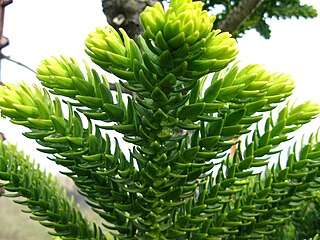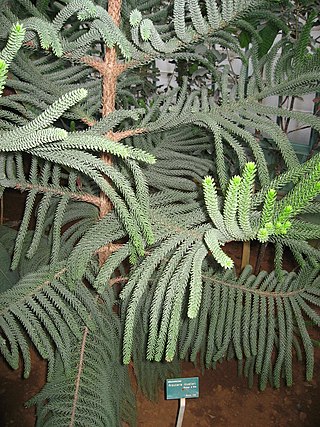
Araucariaceae – also known as araucarians – is a family of coniferous trees, with three living genera, Araucaria, Agathis, and Wollemia. While the family was distributed globally during the Jurassic and Cretaceous periods, they are now largely confined to the Southern Hemisphere, except for a few species of Agathis in Southeast Asia.

Araucaria is a genus of evergreen coniferous trees in the family Araucariaceae. While today they are largely confined to the Southern Hemisphere, during the Jurassic and Cretaceous they were distributed globally. There are 20 extant species in New Caledonia, Norfolk Island, eastern Australia, New Guinea, Argentina, Brazil and Chile.

Araucaria heterophylla is a species of conifer. As its vernacular name Norfolk Island pine implies, the tree is endemic to Norfolk Island, an external territory of Australia located in the Pacific Ocean between New Zealand and New Caledonia. It is not a true pine, which belong to the genus Pinus in the family Pinaceae, but instead is a member of the genus Araucaria, in the family Araucariaceae, which also contains the hoop pine. Members of Araucaria occur across the South Pacific, especially concentrated in New Caledonia where 13 closely related and similar-appearing species are found. It is sometimes called a star pine, Polynesian pine, triangle tree or living Christmas tree, due to its symmetrical shape as a sapling.
Agathis montana, the Mount Panié kauri, is a species of conifer in the family Araucariaceae that is endemic to the higher elevations of Mont Panié in New Caledonia. The Latin specific epithet montana refers to mountains or coming from mountains. Its native name is "Dayu Biik" in Nemi and Fwâi. It is a long-living species, with one recently dead tree of 80 m estimated to be 1,100–1,300 years old based on 14C dating. It is threatened by feral pigs, Phytophthora disease, bark beetles and climate change.

Agathis ovata, the mountain kauri, is a species of conifer, genus Agathis in the family Araucariaceae. It is found only on the southwest Pacific island of New Caledonia. It is threatened by habitat loss.

Araucaria bernieri is a species of conifer in the family Araucariaceae. It is found only in New Caledonia at elevations below 700 meters, mainly in the southern part of the main island. It is a large tree reaching 40–50 meters in height, though specimens growing on poorer soil tend to be dwarfed. It is threatened by habitat loss with a wild population of less than 10,000 mature trees, and ongoing decline in remaining populations.

Araucaria biramulata, the biramule araucaria, or piggyback araucaria, is a species of conifer in the family Araucariaceae. It is found only in New Caledonia on the main island of Grande Terre. Araucaria biramulata is a medium-large tree reaching 30 meters in height. As with several other endemic New Caledonian araucaria species, it is threatened by habitat loss with a fragmented wild population of less than 10,000 mature trees, and ongoing decline in remaining populations, with the main threats being forest fires and mining activities. Piggyback araucaria gets its common name from the unusual growth habit of mature trees, where they often develop a second growth tip halfway up the trunk, giving the appearance of a smaller tree "piggybacking" on the side of a larger one.

Araucaria columnaris, the coral reef araucaria, Cook pine, New Caledonia pine, Cook araucaria, or columnar araucaria, is a species of conifer in the family Araucariaceae.

Araucaria humboldtensis, or Humboldt's araucaria, is a species of conifer in the family Araucariaceae. It is found only in New Caledonia. It is threatened by habitat loss, as even though the remaining wild populations are located within protected park areas, an increased frequency of forest fires in recent years has led to continued degradation of habitat and increased dieback of mature trees.

Araucaria laubenfelsii is a species of conifer in the family Araucariaceae. It is found only on Grande Terre, the main island of New Caledonia, mainly on the southern mountains Mont Mou, Mont des Sources, Mont Dzumac and Mont Dou, though smaller populations also exist on Mont Kaala and Mont Canala in the north. It is one of the larger of New Caledonia's native araucaria species, sometimes reaching up to 50 meters in height in emergent rainforest specimens, and potentially living for as long as 500 years or more. As with other New Caledonian Araucaria species, Araucaria laubenfelsii is threatened by habitat loss, though southern populations at least are considered to be healthy and it is not currently considered vulnerable or endangered. A population genetic study suggested that A. laubenfelsii is doubtfully distinct from the more widespread A. montana.

Araucaria luxurians is a species of conifer in the family Araucariaceae. It is known by the common names Sapin de Noël and Coast araucaria. It is endemic to New Caledonia, where it grows in several small subpopulations. It grows in ultramafic soils in humid forests and on cliffs and slopes. It is threatened by habitat loss and none of the subpopulations are in protected areas.

Araucaria muelleri is a species of conifer in the family Araucariaceae. It is a medium size tree, 10–25 meters in height, with larger leaves than most other New Caledonian Araucarias. It is found only in New Caledonia, in several sites in the far south of Grande Terre, the main island.

Araucaria nemorosa is a species of conifer in the family Araucariaceae. It is found only in New Caledonia, an island possession of France in the South Pacific. It is mostly found as a small understory tree, typically growing to no more than 15 meters, and relatively shade tolerant, though it can also grow as an emergent from coastal scrub. It has feathery foliage somewhat less spiky than most other Araucaria species, and is found only on serpentine soil, in coastal locations below 100m in altitude. It is threatened by habitat loss and is a critically endangered species with less than 5000 trees remaining in the wild. Low levels of genetic variation in the remaining population and consequent low germination rates of seed produced, are also a concern.

Araucaria rulei is a species of conifer in the family Araucariaceae. It is endemic to New Caledonia, where it is an endangered species. Its populations are fragmented and are generally made up of scattered individuals. It is restricted to serpentine soils, often with high nickel levels, and its natural range is almost completely restricted to areas rich in nickel. Nickel mining in New Caledonia has consequently been a major cause of its decline.
Araucaria schmidii is a species of conifer in the family Araucariaceae. It is a medium to large tree growing up to 30 meters tall. It is found only in a small area on New Caledonia, with only one contiguous population in an area covering less than one square kilometer on the summit and highest slopes of Mont Panié in the north-east of the main island, Grande Terre, though a few scattered individuals may still be found on surrounding peaks. It is threatened by habitat loss. While the single remaining population is in a protected national park in a remote area, this area is still regularly visited by tourists, and IUCN has expressed concern that the entire population is at risk of being wiped out by a chance event such as the introduction of a fungal disease.

Araucaria scopulorum is a species of conifer in the family Araucariaceae. It is endemic to New Caledonia, where it is an endangered species. It occurs in small populations that are restricted to two main areas. It grows in shrubland on steep coastal slopes below 300m in altitude. Araucaria scopulorum is a relatively small tree compared to most other araucarias, with mature trees varying from 4–20 meters in height. Much of its habitat is located in areas with active nickel mining operations and no populations are in protected areas.

Araucaria subulata is a species of conifer in the family Araucariaceae. It is found only in New Caledonia, with scattered populations present across the central and southern mountain regions of the main island Grande Terre, especially on Mont Dzumac and Mont des Sources. It is one of the tallest of New Caledonia's endemic araucaria species, reaching up to 50 meters in height. Young trees, like the one in the picture, show similar growth habits to the Norfolk Island Pine. It is threatened by habitat loss as with all of New Caledonia's araucaria trees, but populations of Araucaria subulata are currently considered to be stable and it was not found to be threatened or endangered when most recently assessed.

Araucaria mirabilis is an extinct species of coniferous tree from Patagonia, Argentina. It belongs to the genus Araucaria.
Araucaria haastii is an extinct species of conifer tree formerly native to New Zealand. A large number of fossilised tree specimens from the family Araucariaceae have been found in New Zealand, but in many cases the level of preservation is not sufficient to reliably distinguish between Araucaria species and Agathis species.

The main diversity among genus Araucaria is hosted in New Caledonia, where 14 species, all endemic, are described out of a total of 20 extant species. These New Caledonian species are mainly found as dispersed populations in open areas, where competition is less intense.




















